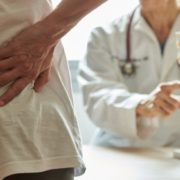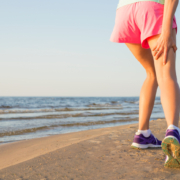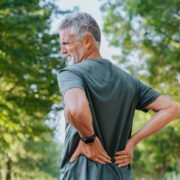Four Surprising Contributors to Lingering Knee Pain
Approximately 25% of adults suffer from lingering, chronic knee pain without any clear reason why. For some, aging and arthritis is to blame, and it’s something to just “live” with. For others, they’re told it’s due to “wear and tear”. Yet despite one or more surgeries to “clean out the knee” – the pain lingers and persists.
So why then, do some folks age, get arthritis, and put tons of wear and tear on their knees without any issue – where others suffer from chronic knee pain? The answers may surprise you.
Let’s look at four lesser-known (and often overlooked) contributors that cause knee pain to linger and not go away.
1. “Hyper” mobility is lacking
I remember early on in my career (22 years ago) when “hyper” mobility was considered a bad thing. But since then, both research and experience have proven me wrong. If you’ve followed me for a while – then you know one of my favorite sayings is “mobility before stability”. That’s because a joint that moves fully and freely feels and functions better – and allows the muscles around that joint to work at their best. Too often, people mistakenly look at muscular strength first as the solution to solving pain, when they should be looking a bit deeper. Regarding knees, you need a bit of what we call “hyper-extension”. But most practitioners tend to focus only on how well a knee is bending. For knees – just getting to straight isn’t good enough. You need a certain amount of “more than straight” – otherwise known as hyperextension. I see this problem most in knees that have had surgery. If their full knee extension (hyperextension) wasn’t restored properly during rehab, or perhaps they didn’t have any rehab at all (common practice now after most arthroscopic knee surgeries), knee pain will persist. And it won’t go away no matter how much you try and strengthen it. Moral of this story – make sure you have full knee extension – which includes a bit of hyperextension – and that it matches your other knee. This could be a reason your knee pain isn’t going away.
2. It’s really a back problem
Did you know that 40% of the time, an extremity problem (aka: knee, shoulder, etc) comes from the spine – even when you don’t have any neck or back pain? It’s more common than you think for knee pain to be caused from your lower back, and when this gets missed, it’s a huge reason for lingering knee pain that never seems to get resolved. With a true knee problem, your symptoms tend to be pretty specific and localized to just your knee joint. But if your pain tends to move around your knee, or travels up and down your leg, there’s a good chance your knee pain is coming from your back. If you’ve been treating your knee for months (or years) – and it’s not going away – consider that your knee problem is actually a back problem. This could be especially true if you’ve had cortisone injections and/or various procedures done to your knee with little or no effect.
3. Poor core strength
When it comes to core strength, most people associate it with something that’s important for resolving and preventing back pain. But good core strength is vital to good knee health as well. Your abdominals, low back muscles, hips, and glutes all make up what we call your “powerhouse” – otherwise known as your core. Your powerhouse – specifically your hips and glutes – have a huge influence on how well your lower extremities function. If your core is weak, your legs will need to work harder and eventually overcompensate. And knee joints often take the brunt of all this. The truth is, although your knees require a certain amount of stability to function well – they aren’t designed to be a stabilizing joint. That’s what your hips and ankles are for. If your core is weak (particularly hips and glutes), and your knees start trying to help out as an extra stabilizer, this could be the reason why they keep hurting. If you haven’t yet gotten your core strength properly assessed – do it – this could be the culprit.
4. Weak ankles
As I alluded to above – if your ankles aren’t strong enough to stabilize your foot and lower leg, your knees will kick in to help. If this pattern is allowed to continue – your knees will start to hurt – and will keep hurting until the pattern is discovered and fixed. Another interesting phenomenon that can occur in any joint (not just your ankles) is that when a joint lacks strength or stability – it will stiffen up to compensate. So in terms of your ankles – if they lack range of motion on top of being weak – your knees will really pay the price. This is particularly evident during activities such as running, hiking, pickleball, or tennis. You need really good mobility and stability of your ankles for these activities – or your knees will suffer in response. If you’ve got lingering knee pain and haven’t yet taken a look at your ankles – I recommend doing so – they could be the overlooked issue.
Knee pain can be tricky to figure out – especially if it’s chronic. The key to successfully getting rid of knee pain starts with correctly identifying the cause. And from my experience – arthritis, age, and wear and tear serve as “excuses” when a practitioner doesn’t know where to look. If you’re suffering from chronic knee pain and haven’t yet explored any of the four lesser-known contributors I mentioned in this article – talk to a specialist who knows how to look at the big picture instead of just your knee – because the true cause could be elsewhere.
Are you local to Portsmouth, NH?
CLICK HERE to speak with one of my specialists for free.
Dr. Carrie Jose, Physical Therapist and Pilates expert, owns CJ Physical Therapy & Pilates in Portsmouth and writes for Seacoast Media Group. To request a free copy of her Knee Pain Free Report CLICK HERE or to get in touch, email her at [email protected].











